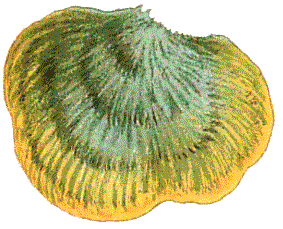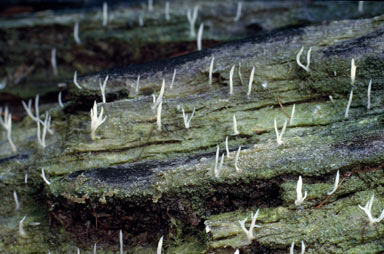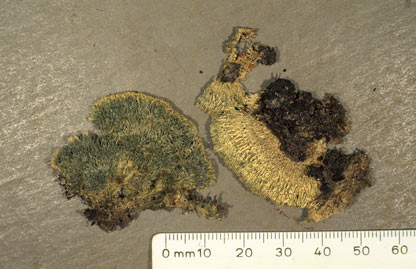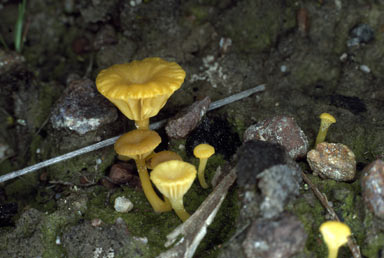
Basidiolichens
The great majority of lichens have ascomycetes as the mycobiont. Of the 18,000 or so known lichens fewer than 50 have basidiomycete mycobionts and such lichens are referred to as basidiolichens![]() .
.
What do they look like?
The fruiting bodies of basidiolichens come in several forms but in many species the thalli are not immediately obvious.
Lichenomphalia chromacea ![]() is widespread in the non-arid parts of southern Australia, can be seen often and it is natural to think of it as simply one of the many species of small, colourful mushrooms that can be found in Australia. Lichenomphalia chromacea caps can be up to three centimetres in diameter, though more commonly they are between one and two centimetres. The mushrooms grow on the ground and, though small, the bright colour and the fact that they often appear in large numbers
is widespread in the non-arid parts of southern Australia, can be seen often and it is natural to think of it as simply one of the many species of small, colourful mushrooms that can be found in Australia. Lichenomphalia chromacea caps can be up to three centimetres in diameter, though more commonly they are between one and two centimetres. The mushrooms grow on the ground and, though small, the bright colour and the fact that they often appear in large numbers ![]() makes them easily seen. Unless you look more closely you are likely to conclude that these yellow mushrooms are growing on bare soil, but that 'bare' soil has a green 'algal' layer around the bases of the mushroom stems. In fact fungal hyphae are associated with the algae and that somewhat indistinct mix of hyphae and algal cells constitutes the lichen thallus. The yellow mushrooms are where the fungal partner of this lichen produces spores and in this species the fruiting bodies clearly dominate the thallus in terms of size and visibility. You can find many mushrooms of non-lichenized species growing on soil, even amongst algal cells, but where the juxtaposition is coincidence and not evidence of lichenization.
makes them easily seen. Unless you look more closely you are likely to conclude that these yellow mushrooms are growing on bare soil, but that 'bare' soil has a green 'algal' layer around the bases of the mushroom stems. In fact fungal hyphae are associated with the algae and that somewhat indistinct mix of hyphae and algal cells constitutes the lichen thallus. The yellow mushrooms are where the fungal partner of this lichen produces spores and in this species the fruiting bodies clearly dominate the thallus in terms of size and visibility. You can find many mushrooms of non-lichenized species growing on soil, even amongst algal cells, but where the juxtaposition is coincidence and not evidence of lichenization.
Semiomphalina leptoglossoides (the only species in the genus) has a white and somewhat spathulate fruiting body - a thin, flat area (about 1 x 2 centimetres in area and a couple of millimetres thick) attached to the substrate by a lateral stem. The fertile underside of the broadened apical part is smooth. The thallus is a thin green film and there is some evidence to suggest this species is closely related to Lichenomphalia![]() .
.
The fruiting bodies of Multiclavula mucida are short white clubs or spikes, up to a centimetre or so tall and sometimes branched. A number are shown on the right, growing on damp wood. You can also see what looks like an algal mat on the wood and that green mat is the lichen thallus, composed of both algal cells and hyphae, while the spikes or clubs are the fruiting bodies and grow to a centimetre or so in length. There are several other species of Multiclavula, the fruiting bodies are mostly club-like but in one, Multiclavula icthyiformis, the fruiting body has a short stem and then broadens to a thin, somewhat fishtail-like apex. Short, club-like fruiting bodies are produced by species of the genus Lepidostroma but in this genus the thallus is squamulose rather than a thin greenish film. The thalli of Lepidostroma calocera and Lepidostroma rugaramae are noteworthy in that they have an 'inverse' structure, with the photobiont found in the lower medulla and hence close to the substrate. Such an arrangement is found in some LICHENS IN ARID AREAS and is considered an adaptation to life in hot, dry habitats. That would hold for Lepidostroma rugaramae, which is known from exposed sites in frequently burned areas of Rwanda, but Lepidostroma calocera occurs in montane rainforests of Central and South America. The fruiting body of Cyphellostereum pusiolum is only about a half centimetre tall and is more-or-less spathulate in form. As with Multiclavula the thallus is superficially an algal-like film on the soil surface![]() .
.
The species of Dictyonema ![]() generally produce easily visible thalli which are often more-or-less semicircular in shape and growing in rosettes - though Dictyonema moorei has an almost crustose thallus. An individual thallus may be several centimetres in diameter and in most species is predominantly some shade of green. The basidia are produced on the underside of the thallus. In a well-developed specimen the underside will be a smooth, whitish sheet which is composed of fungal hyphae and bearing abundant basidia. At an earlier stage of development you may see the underside bearing numerous, discrete whitish patches
generally produce easily visible thalli which are often more-or-less semicircular in shape and growing in rosettes - though Dictyonema moorei has an almost crustose thallus. An individual thallus may be several centimetres in diameter and in most species is predominantly some shade of green. The basidia are produced on the underside of the thallus. In a well-developed specimen the underside will be a smooth, whitish sheet which is composed of fungal hyphae and bearing abundant basidia. At an earlier stage of development you may see the underside bearing numerous, discrete whitish patches ![]() and these would eventually coalesce to produce the almost continuous, smooth, white undersurface. If you do search for information about Dictyonema be aware that it is also the name of a genus of fossilized animals amongst the Graptolites. In Dictyonema the thallus is dominant and the same is certainly true for the foliose basidiolichen Marchandiomphalina foliacea, since spore production has not been seen in that species. The grey-green thallus of that species is up to two centimetres in diameter, gelatinous when wet but brittle when dry. Another basidiolichen which has not been seen to produce spores is Acantholichen pannarioides in which the thallus is squamulose, the individual squamules being a millimetre or two in diameter. These two sterile species produce soredia as vegetative propagules. Acantholichen pannarioides and Marchandiomphalina foliacea are the only species in those two genera. Basidiolichen photobionts are mostly algal but Acantholichen and Dictyonema have cyanobacterial photobionts
and these would eventually coalesce to produce the almost continuous, smooth, white undersurface. If you do search for information about Dictyonema be aware that it is also the name of a genus of fossilized animals amongst the Graptolites. In Dictyonema the thallus is dominant and the same is certainly true for the foliose basidiolichen Marchandiomphalina foliacea, since spore production has not been seen in that species. The grey-green thallus of that species is up to two centimetres in diameter, gelatinous when wet but brittle when dry. Another basidiolichen which has not been seen to produce spores is Acantholichen pannarioides in which the thallus is squamulose, the individual squamules being a millimetre or two in diameter. These two sterile species produce soredia as vegetative propagules. Acantholichen pannarioides and Marchandiomphalina foliacea are the only species in those two genera. Basidiolichen photobionts are mostly algal but Acantholichen and Dictyonema have cyanobacterial photobionts![]() .
.
Where do you find them?
Dictyonema is generally a tropical to sub-tropical genus (and is found in many such areas, with some species more widespread than others) but occasionally is also found elsewhere. For example outside the tropics Dictyonema moorei is known from Chile, southern Japan and south-west Western Australia. This species is also known from Queensland and the other Dictyonema species recorded from Australia are Dictyonema irpicinum, Dictyonema ligulatum and Dictyonema sericeum. They are known from tropical (or sub-tropical) eastern Australia, generally on the coastal side of the Great Dividing Range - though the last occurs also in Tasmania's cool-temperate rainforests. The genus Lichenomphalia is widespread, from the tropics to high latitudes and two species have been reported from Australia: Lichenomphalia chromacea and Lichenomphalia umbellifera, both from many non-arid areas in the south of the country. The first published description of Lichenomphalia chromacea was based on specimens collected in South Australia and it was published in 1924. Semiomphalina leptoglossoides is known only from specimens collected in the Wau area of Papua New Guinea. Multiclavula is known from Europe, the Americas and Australia. The species found in Australia are Multiclavula mucida and Multiclavula vernalis, both from Tasmania and the former also from southern coastal New South Wales. Cyphellostereum pusiolum is well-known from Central and South America as well as the Papua New Guinea and the Asian and African tropics. Lepidostroma is known from the African and American tropics and Acantholichen pannarioides and Marchandiomphalina foliacea are found in Central and South America![]() .
.
Spore dispersal
Though there have been no investigations of spore dispersal in the basidiolichens there have been studies of spore dispersal in the non-lichenized basidiomycetes. Such studies have shown that spores ejected from basidia typically travel only a fraction of a millimetre. In mushrooms the basidia are on gill faces and shoot the spores into the still air between the gills. Air resistance stops the spores and they fall under the force of gravity until they are clear of the bottom of the cap and then are carried away by air currents. Spores ejected from the basidia on club-like fruiting bodies or from the fertile undersides of Dictyonema thalli may be quickly exposed to air currents. On the other hand where fruiting bodies grow very closely clustered or overlapping (such as the rosettes of Dictyonema) it is likely that many spores fall on the lower thalli, with only a small number being carried further away. In such cases one has to wonder if invertebrates help in further dispersal.
Evolutionary relationships
The thallus and fruiting body forms of Dictyonema and Lichenomphalia are quite different, but DNA analyses show these genera to be closely related. Studies on non-lichenized basidiomycetes have also shown that genera with strikingly different fruiting bodies can be closely related and there was evidence of that before the advent of DNA studies. The DNA evidence indicates that Dictyonema is not a homogenous genus and would be best divided into two, in order to better reflect the evolutionary history. Furthermore the DNA evidence indicates that Acantholichen and Cyphellostereum are very closely related to Dictyonema and that this group of genera is closely related to the non-lichenized, bryophilous genus Arrhenia and a bryophilous ancestor is posited for the group consisting of Arrhenia, Acantholichen, Cyphellostereum and Dictyonema. These genera and Lichenomphalia are placed in the family Hygrophoraceae. While this family contains most of the lichenized basidiomycetes it also contains numerous non-lichenized species, most of which produce small, typically brightly coloured mushrooms as fruiting bodies![]() .
.
You've seen that closely related species need not have similar fruiting bodies and it is also true that just because two species have very similar fruiting bodies does not mean that those species are very closely related. Multiclavula and Lepidostroma have similar fruiting bodies and some Lepidostroma species were initially named as species of Multiclavula, yet the two genera are not very closely related. Whereas Acantholichen, Cyphellostereum, Dictyonema and Lichenomphalia are placed in the family Hygrophoraceae the other genera of basidiolichens are only distantly related to this family, and to each other. The current evidence indicates that the property of lichenization has arisen independently several times in the basidiomycetes and that once gained has not been lost. By contrast lichenization appears to have been gained or lost several times in the ascomycetes and there's more on the ascolichen CLASSIFICATION page![]() .
.
Marasmiellus affixus - lichenized? Perhaps...perhaps not
There are several basidiomycete species which have been claimed to be lichenized but for which no proof of lichenization has been published. The claims have been based simply on the fact that the fruiting bodies always (or at least very often) grow near algae. That alone is not proof of lichenization and at least several dozen basidiomycetes have been found to be capable of attacking and parasitizing algae, rather than lichenizing with them.
Marasmiellus affixus is one of these non-proven 'lichenized' species that is found in Australia. The fruiting bodies are small mushrooms, found in the sclerophyll forests of Tasmania and south-eastern mainland Australia. The first published description of Marasmiellus affixus, in 1848, was based on specimens collected in Tasmania and the first claim of lichenization appears to have been made in the 1970s. The mushrooms appear on live bark or dead wood, are typically numerous, with the off-white to pale brownish caps up to a centimetre in diameter, but often smaller. Marasmiellus affixus appears to be the only species of Marasmiellus for which a claim of lichenization has been made. Many species had been described in this genus but a large number have been re-named so that currently the genus contains about 20 species. Thus far, there have been no DNA studies of Marasmiellus affixus and hence no evidence from that source as to the species' relationships with other basidiomycetes![]() .
.
The MARASMIELLUS AFFIXUS CASE STUDY has more information.
![An Australian Government Initiative [logo]](/images/austgovt_brown_90px.gif)




